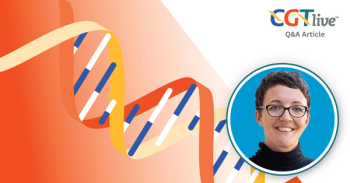
RPE65 Gene Therapy Effective for Retinal Dystrophy
AAV2/5-OPTIRPE65 showed improvements in vision-guided mobility, retinal sensitivity, and foveal-driven visual function for patients with RPE65-associated retinal dystrophy.
Michel Michaelides, BSc, MB BS
Subretinal administration of the gene therapy AAV2/5-OPTIRPE65 showed improvements in vision-guided mobility, retinal sensitivity, and foveal-driven visual function for patients with RPE65-associated retinal dystrophy, according to findings from a phase 1/2 study presented at the
In the early-stage study, there was a significant change in the ability to complete a maze across lux levels when using the treated eye versus the fellow eye for navigation. At a mean 24 weeks from baseline following treatment with AAV2/5-OPTIRPE65 across all doses, patients navigated the maze 77.41 seconds quicker using the study eye versus the fellow eye (P = .0017). Moreover, there were significantly fewer errors in the treated group and the agent was well-tolerated.
"In terms of efficacy, we saw statistically significant improvements in vision-guided mobility," said Michel Michaelides, BSc, MB BS, from the UCL Institute of Ophthalmology & Moorfields Eye Hospital. "Our data suggest that our optimized vector improved functional vision, retinal function, and central vision."
Deficiency in the RPE65 gene causes a lack of rod function and leads to slowly progressive degeneration, with outer retina degeneration typically seen by the third generation of life. The AAV2/5-OPTIRPE65 gene therapy vector is an intron and codon-optimized transgene with an AAV5 capsid designed to deliver a normal copy of the RPE65 gene. In RPE65-deficient mice, the therapy was able to restore function at significantly lower doses than first-generation agents.
The phase 1/2 study included patients aged 3 or older with confirmed balletic RPE65-associated retinal dystrophy in an initial dose escalation cohort. All patients had structural evidence of photoreceptor preservation on SD-OCT. Three doses of AAV2/5-OPTIRPE65 were explored in the study: 1 x 1011, 3 x 1011, and 1 x 1012, all up to 1 ml. Treatment was administered as a subretinal injection into 4 subretinal blebs to target the entire central retina and involving foveal detachment. Overall, 8 mazes were utilized to measure navigation, and different mazes were used from baseline to 24 weeks for each patient.
Across the phase 1/2 portions of the study, 15 patients were enrolled. Of these patients, 9 were young adults with a mean age of 19.9 years and 6 were children at a mean age of 9.3 years. Most patients were treated in the United Kingdom at the Moorfields Eye Hospital, with 2 pediatric patients treated in the United States at the Michigan Kellogg Eye Center. The 1 x 1011 dose was selected for a pediatric expansion cohort enrolling 6 patients.
Across all patients treated with the dose selected for further study (1 x 1011; n = 9), there was a 107.73 seconds improvement in the time needed to navigate the maze for the treated-eye versus the fellow eye at week-24 (P = .0039). In pediatric patients treated with the 1 x 1011 dose (n = 6), there was a 131.52 seconds improvement across all lux levels with AAV2/5-OPTIRPE65 treatment (P = .031).
There was a significant improvement in retinal sensitivity in eyes treated with the gene therapy. Across all doses and treated patients at 24 weeks (N = 14), there was a 3.0922 dB-sr increase in volume of total hill of vision for patients treated with the gene therapy versus the fellow eye. In patients treated with the 1 x 1011 dose, there was a 9.39 dB-sr improvement in the treated versus untreated eyes. In pediatric patients treated at the 1 x 1011 dose (n = 5), there was a 12.58 dB-sr improvement in mean volume of total hill of vision with AAV2/5-OPTIRPE65.
At 6 months, there was an improvement in foveal-driven visual function with AAV2/5-OPTIRPE65 at 1 x 1011. The BCVA improved by a median of 4.3 letters in all patients treated at the 1 x 1011 dose and by 5.3 letters in children specifically (P = .031). There were also improvements in contrast sensitivity (P = .016), reading speed (P = .078), and central visual field (P = .008).
The most common adverse event was inflammation, which was seen primarily at the intermediate and high doses in 3 out of 6 patients (50%). For most patients, steroid cover was extended to treat this event. "Inflammation may have mitigated efficacy in these cohorts," Michaelides noted. "The therapy was generally well-tolerated. Importantly, there was no retinal thinning observed, including following foveal detachment."
Based on prior findings from studies exploring AAV2/5-OPTIRPE65, the FDA has granted the therapy a rare pediatric disease designation for the treatment of inherited retinal dystrophy due to biallelic RPE65 disease-causing variants. The therapy is also being explored for patients with Leber congenital amaurosis.
Michaelides M, Kumaran N, Georgiadis T, et al. Six-Month Results of a Phase 1/2 Study of AAV2/5-0PTIRPE65 Gene Therapy for the Treatment of RPE65-Associated Retinal Dystrophy. Presented at: 2019 AAO Annual Meeting, San Francisco, CA, October 12-15, 2019.
Newsletter
Stay at the forefront of cutting-edge science with CGT—your direct line to expert insights, breakthrough data, and real-time coverage of the latest advancements in cell and gene therapy.































